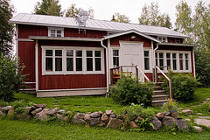Environmental building a crutch for deforestation
The effects of human induced deforestation on the environment may not all be negative and under some economic scenarios it could become beneficial. These include the use of timber in construction; with market opportunities now having spread to China and Japan.

 The effects of human induced deforestation on the environment may not all be negative and under some economic scenarios it could become beneficial. These include the use of timber in construction; with market opportunities now having spread to China and Japan.
The effects of human induced deforestation on the environment may not all be negative and under some economic scenarios it could become beneficial. These include the use of timber in construction; with market opportunities now having spread to China and Japan.
There is a rising social need for buildings, and the most environmental way to meet this could be via timber use, rather than concrete and steel use, which emit higher levels of CO2, argue researchers at the Center for International Trade in Forest Products (CINTRAFOR).
Meeting social and economic demand for construction through sustainable timber production could be an effective method of mitigating some impacts of global warming.
Dr. Ivan Eastin and researchers at CINTRAFOR, (October 2010) suggest that the trend for environmental wood building has spread.
In the journal, The Impact of Green Building Programs on the Japanese and Chinese Residential Construction Industries and the Market for Imported Wooden Building Materials, researchers state that builders in both countries widely perceive that the environmental performance of wood is superior to that of steel and concrete.
This research suggests that the adoption of green building programs in Japan and China could provide a variety of market opportunities for expanding exports of value-added wooden building materials into these countries.
Research by the Building Research Establishment (BRE) in the United Kingdom, conducted in 2000, suggests that wood has the best environmental attributes among all building materials.
The study found that timber's low embodied energy and carbon storage properties give it a positive impact. This applies even when taking account of the CO2 released through its transportation and processing, it suggests.
An argument, however, is that not all carbon is sequestered, but is released in the form of methane. Methane emitted by rotting tree stumps is important in the analysis of greenhouse gases (GHG) emissions. Alternatively, in some countries such as Finland, tree stumps are burned for energy. It appears that parts of the tree which are not used for building will emit GHG via decaying or burning. Timber used for building will also emit GHGs in the future via the same processes.
A downside of building with timber is its vulnerability to termites, wood destroying beetles, carpenter ants and decay fungi, to name a few. Borates can be used to protect wood and keep it durable.
John-Mark Clancy, General Director of O'Connor Sutton Cronin Consulting Engineers LLC in Moscow, said in an interview: "Very little pollution, if any, occurs during the process of utilising [wood] for construction…steel and concrete production use huge amounts of energy and are highly polluting during manufacture. Also timber when taken from sustainable forests is 100 per cent recyclable."
Sustainable forest management (SFM) can provide multiple environmental benefits while providing economic and social advantages to indigenous farmers and stakeholders.
"Furthermore since timber is a natural insulator -- whereas concrete and steel conduct heat -- it very much helps to assist in the insulation of buildings," stated Clancy.
With the environmental attributes of wood as a building material having been further accepted across key developing nations, a number of market opportunities have arisen for exporters in the US, Russia, Canada, New Zealand and Australia among others.
Author: Marianna Keen | Climate Action
Image: Tom Plesnik | Flickr






